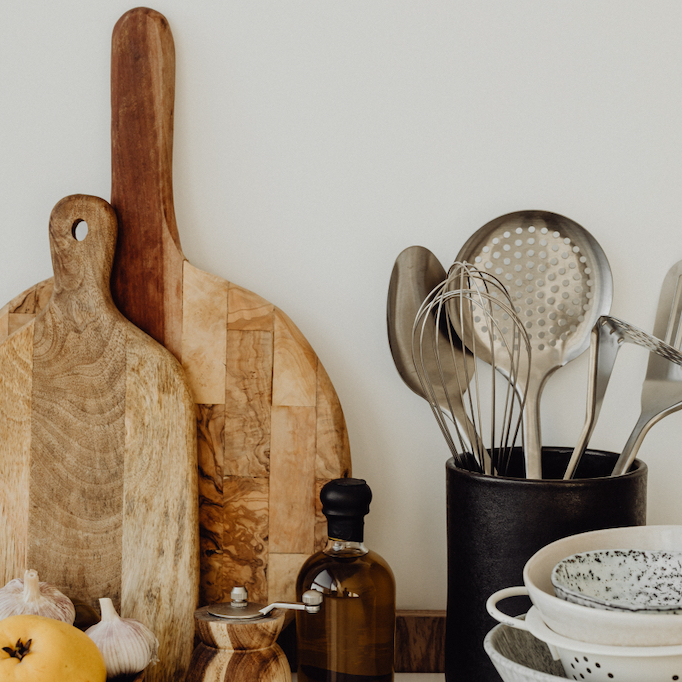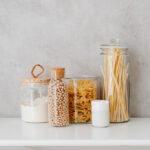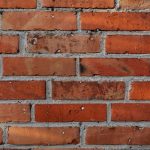
Do you want to organize kitchen utensils at home?
Are you looking for some ideas on how to manage your tools and keep things organized?
Kitchen utensils come in all different shapes, sizes, and forms.
Some have short handles, while others have long ones.
Some have solid ends, while others have convenient holes, loops, or tassels.
No wonder organizing them can be such a challenge!
In this post, you’ll find some tips to help you declutter and organize kitchen utensils in your home.
Take stock of your kitchen utensils.
If you like to cook and/or enjoy kitchen gadgets, you may have accumulated quite a lot of utensils over the years.
Before you set off organizing all of your kitchen utensils, it’s wise to take stock of your collection to see if you can pare things down a bit.
You don’t want to spend your time finding organization and storage solutions for utensils you no longer need.
Begin by locating and setting aside your favorite, and most frequently used tools.
Once you’ve done that, go through the remainder to find any broken, damaged, duplicate, or unwanted utensils.
Appropriately recycle or trash items where necessary. If items are unopened, you may want to donate them.
Group like items with like.
The next step is to assemble and organize similar utensils with similar utensils.
The idea here is that you will be able to reach for similar items quickly, and easily, while you are cooking or baking.
As a very basic example, you could group wooden spoons with wooden spoons, knives with knives, and colanders with colanders.
Another way to group like items with like is by their usage.
Spatulas, ladles, and large slotted spoons might be grouped together.
These items are used mainly on stove top burners.
Knives, vegetable peelers, corers, and the like might be grouped together.
Why? Because they are used on cutting boards or chopping blocks.
The sky is truly the limit here, so don’t be afraid to get creative with your organization methods!
Decide on general storage areas.
Once you’ve grouped utensils together in a way that makes sense to you, it’s time to decide where items will be stored.
Keep in mind, you’re just deciding on the general storage locations for items within your kitchen.
Don’t worry, we’ll shortly deal with specific storage options.
You know your kitchen best, so use your own discretion when it comes to these storage areas.
If need be, you may want to review your kitchen area and jot down a few ideas on a piece of scrap paper.
Generally speaking, you’ll want to keep utensils within an arm’s reach, or within a few feet, from major appliances, countertops, and tables.
This eliminates any unnecessary trips back and forth across the kitchen to find the tool you need.
So, you’d probably want to keep spatulas, slotted spoons and the like relatively close by as you cook on a stove top.
Knives can be at your fingertips on a countertop or table. Potholders should be within relatively easy reach of an oven.
Select appropriate storage solutions.
Lastly, it’s time to choose appropriate storage solutions for your needs.
Your storage solutions will depend on the size of your kitchen and the available countertop, table, wall, drawer, and shelf space.
Taking all of these factors into consideration, which storage options would suit you best?
Here are seven common and popular ways in which to store kitchen utensils:
- Sitting on a shelf in a cabinet
- Hanging from a hook
- Nestled in a drawer
- Hanging from a magnetic strip
- Stored upright in a jar, vase, or other sturdy vertical container
- Stored in a custom-made or specially designed utensil block
- Stored in a sectioned-tray in a drawer
You may already own several of these items. You may need to rearrange or reorganize their location in your kitchen.
Still in the process of setting up your kitchen or lacking in storage solutions and ideas?
Go online or visit the store to get an idea of the types of storage products available.
Just how can you use these storage methods for utensils? Here are a few ideas to get you started:
Colander
- Sitting on a shelf in a cabinet
- Hanging from a hook
- Nestled in a drawer
Wooden spoons, rubber scrapers, and metal spoons
- Hanging from a hook
- Stored in a sectioned-tray in a drawer
- Stored upright in a jar, vase, or other vertical container
Knives
- Wooden knife block
- Hanging on a wall mounted on a magnetic strip
- Sectioned-knife storage in a drawer
Small nesting measuring cups with holes
- Wall mounted on a magnetic strip (this works only if the item in question is metallic)
- Hanging from a series of hooks
- Looped together with an adjustable mini-chain or twine and placed inside a drawer
How about you? Are you going to give any one of the above methods a try? Join the conversation and leave a comment below!





Appropriate storage solutions are excellent way to store kitchen products safe. I agree that, storage solutions will depend on the size of your kitchen and the available wall, drawer, and shelf space. Thanks for sharing..!!
Thanks for your comment!